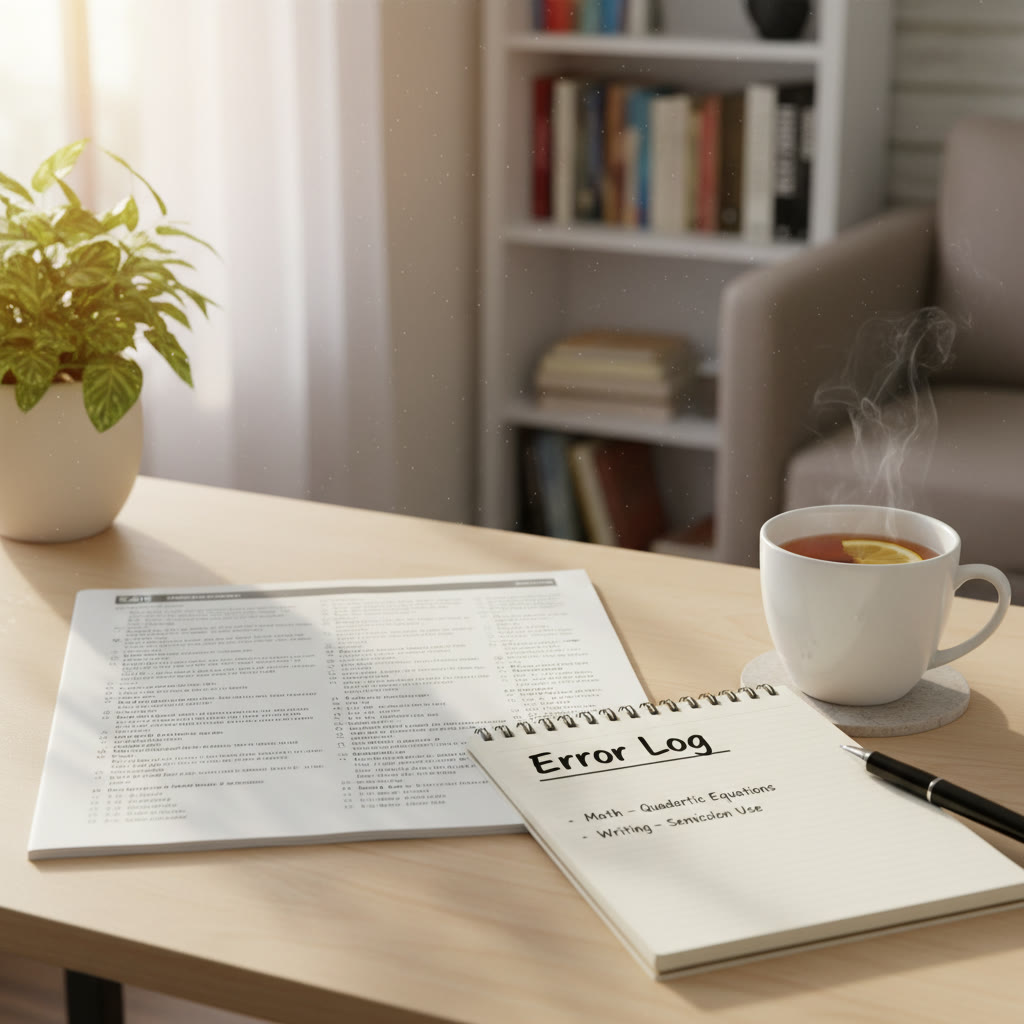Why a Low Practice Score Is Not a Failure
Take a breath. That sinking feeling after a low practice SAT score is familiar to nearly everyone who’s prepared for a big test. It stings, sure — like getting the first dent in a bike you just bought. But it’s not a sign you’re broken. In reality, a low practice score is one of the most helpful gifts you can receive: objective feedback. It shows you exactly where to focus, what to strengthen, and how to shape a smarter plan.
Reframe the Result
Instead of interpreting a low score as proof you can’t improve, treat it as a diagnostic tool. Doctors run tests to find what’s wrong; mechanics listen to the car. The same goes for the SAT. Each wrong answer is a clue. Your job is to read the clues, not to punish yourself for them.
Immediate Steps to Calm Down and Refocus
1. Give yourself 24 hours
Emotion is contagious: if you respond by panicking, you’ll make decisions from a stressed place. Take the rest of the day to do something that resets your brain — a walk, a movie, cooking with a friend. After 24 hours, you’ll be in a clearer headspace to analyze the score.
2. Don’t junk the test — analyze it
Go through the practice test calmly. Circle question types you missed, note timing issues, mark careless mistakes. Instead of counting failures, categorize them. Common categories include:
- Concept gaps (e.g., quadratic equations, main idea questions)
- Strategy errors (e.g., reading too fast, lacking process of elimination)
- Careless mistakes (e.g., misreading a sign or arithmetic slip)
- Timing problems (running out of time on a section)
Build a Recovery Plan That Actually Keeps You Motivated
1. Set micro-goals, not giant halos
Big goals like “raise my score by 200 points” are inspiring but emotionally distant. Break that into micro-goals you can achieve this week: “Correctly solve 10 algebra practice problems this week” or “Read and annotate two SAT passages with timing.” Micro-goals create quick wins that release dopamine and keep your motivation steady.
2. Make goals SMART
SMART = Specific, Measurable, Achievable, Relevant, Time-bound. Instead of “get better at grammar,” say: “By next Saturday, complete 5 grammar exercises on subject-verb agreement, and reduce errors by 50% compared to this practice test.” SMART goals give direction and measurable progress, which fuels motivation.
Turn Analysis into Action: A Practical Workflow
1. Create an error log
Every time you miss a question, add it to a simple log: section, question type, mistake reason, and the correct approach. Over time the log becomes a customized curriculum highlighting exactly what to drill.
2. Prioritize weaknesses by impact
Not all mistakes carry the same weight. Missing a grammar punctuation question is different from misunderstanding algebra fundamentals. Prioritize topics that: (a) appear frequently on the test, and (b) you can improve relatively quickly. This maximizes score gains and boosts confidence faster.
3. Mix focused practice with full timed sections
Do targeted drills for weak areas, then immediately follow with a timed section to transfer learning under pressure. For example, spend 30–45 minutes on geometry problems, then take one timed math section. This alternation trains both skill and stamina.
Sample Week: A Manageable, Motivating Study Plan
This sample week blends focused skill work, timed practice, review, and rest. It’s deliberately light on any one day so you can stick with it — consistency matters more than marathon sessions.
| Day | Session | Time | Focus |
|---|---|---|---|
| Monday | Session A | 60 minutes | Review error log: algebra fundamentals (10 problems), review solutions |
| Tuesday | Session B | 45 minutes | Reading: practice passage, annotation strategies, timing drills |
| Wednesday | Session C | 90 minutes | Full timed Math section + detailed review |
| Thursday | Session D | 60 minutes | Grammar drills: common sentence errors, targeted practice |
| Friday | Light Review | 30 minutes | Flashcards/vocab and mental warm-ups |
| Saturday | Full Practice | 3–4 hours | One full practice test (timed) then relaxed review of mistakes |
| Sunday | Rest & Reflection | — | Light reading, physical activity, plan next week |
Why this works
Small but regular practice reduces burnout. Alternating heavy and light days gives your brain time to consolidate learning. Saturday’s full test trains endurance and simulates test pressure — key for improving final scores.
Strategies to Preserve and Rebuild Motivation
1. Keep a visible progress dashboard
Motivation thrives on evidence. Track practice-test scores, error log reductions, or time-per-question improvements on a simple chart. Visual progress — even small upward ticks — is tremendously motivating. If you use tutoring or an app, many offer AI-driven insights and dashboards that make progress easy to see.
2. Use accountability that feels supportive
Tell a friend, a parent, or a coach about your weekly goals and ask them to check in. Accountability should be supportive, not shaming. If you prefer structured accountability, 1-on-1 guidance from an expert tutor can create regular checkpoints, personalized correction, and emotional encouragement — especially when you’re recovering from a setback.
3. Reward systems that actually work
Design small, immediate rewards for micro-goals: a favorite snack after a productive session, a Netflix episode after completing a timed section, or a coffee with a friend after consistent study days. Rewards should reinforce the habit, not undermine it.
Practical Techniques for Specific SAT Sections
Reading
- Active reading: annotate main idea, tone, and passage structure in the margins. This prevents drifting and sharpens comprehension.
- Passage triage: quickly decide which passages you’ll tackle first based on content comfort and timing.
- Practice paraphrasing: after a paragraph, say or write a one-sentence summary. It improves retention and speeds up answering detail questions.
Writing & Language
- Master the most common grammar rules (subject-verb agreement, punctuation, parallelism) with targeted drills.
- Read the sentence in context: sometimes the best answer fixes the paragraph flow, not just a single sentence.
- Develop a quick checklist for common errors so you can scan efficiently under time pressure.
Math
- Get comfortable with foundational topics (algebra, functions, ratios). If you don’t know a concept, stop and review — don’t guess repeatably.
- Practice solving algebraic expressions both symbolically and numerically so you can choose the faster route on test day.
- When stuck, plug in numbers to test answer choices — often faster than pure algebra.
Measure Progress With Smart Metrics
Instead of only tracking raw score, consider these motivating metrics:
- Percentage of problems in your error log you’ve corrected on a second attempt
- Average time per question for each section
- Number of consecutive study days completed
- Reduction in careless mistakes (e.g., arithmetic errors) per test
| Metric | Baseline | 4-Week Target |
|---|---|---|
| Error log corrections | 10% | 60% |
| Average time per reading question | 80 seconds | 55 seconds |
| Full practice tests per month | 0–1 | 2–3 |
Mindset: What Really Motivates People to Keep Going
Research on learning and motivation shows that confidence is built through mastery experiences — small wins that add up. So your strategy is not a wild sprint but a compilation of wins: one fixed error, one faster reading passage, one timed section completed without panic. Each success rewires how you view the test.
Use self-talk that helps
Replace “I’m terrible at math” with “I haven’t mastered this topic yet, but I can practice it this week and see improvement.” Shifting phrasing from identity to process changes how your brain reacts to setbacks.
Normalize setbacks
Top performers don’t hit perfect scores every time; they use low results as feedback. Famous athletes and musicians often talk about failing as part of practice. Think of your low score the same way: data from practice that sharpens your next move.
When to Get Extra Help (And How It Boosts Motivation)
If you’ve tried self-study for several weeks with only small, inconsistent gains, consider targeted help. Personalized tutoring can make a big difference by:
- Providing 1-on-1 guidance that addresses your exact error patterns
- Delivering tailored study plans so you’re not wasting time on what you already know
- Offering expert tutors who model thinking and strategy in real time
- Using AI-driven insights to highlight trends in your performance and suggest efficient practice
Sparkl’s personalized tutoring, for example, combines 1-on-1 guidance, tailored study plans, and AI-driven insights so you get targeted feedback and ongoing accountability — a strong combo when you’re trying to rebuild motivation from a setback.
The Human Side: Energy, Sleep, and Balance
Motivation isn’t just mental — it’s physical. Sleep, nutrition, and exercise have disproportionate effects on attention, memory, and mood. Prioritize 7–9 hours of sleep, hydrate, and move your body. You’ll find practice sessions are more productive, which in turn keeps motivation up.
Avoid burnout
Studying without breaks is inefficient. Use techniques like Pomodoro (25 minutes focused, 5 minutes break) and schedule at least one full day off per week. Rest makes the next study block richer and prevents motivation from draining away.
Celebrate Progress — Small and Large
Don’t wait for a big score jump to celebrate. Mark milestones: finishing a set of error-log problems, shaving 10 seconds per reading question, or completing consistent study days. If you’re working with a tutor, share these victories — tutors can amplify motivation by highlighting improvements you might overlook.

Test Day Mindset and Rituals
On test day, your goal is to perform what you practiced. Use a simple routine: good night’s sleep, healthy breakfast, arrive early, and a 5-minute breathing exercise before you begin. Carry a confidence ritual — a short phrase, a successful memory, or a physical cue — that helps you reset between sections.
Example Recovery Timeline: From Low Score to Sustainable Improvement
Here’s a realistic 8-week progression after a disappointing practice score:
- Weeks 1–2: Analyze the test, build an error log, set SMART micro-goals, and correct the most frequent question types.
- Weeks 3–4: Increase focused practice on weaknesses, add one timed section per week, and introduce a weekly full practice test.
- Weeks 5–6: Shift more time to mixed practice and timed sections, track metrics, and celebrate mid-course wins.
- Weeks 7–8: Peak with two full practice tests per week, replicate test-day conditions, and polish timing and stamina.
If progress stalls at any point, a short cycle with a tutor or a targeted review session can break the plateau. Sparkl’s expert tutors and tailored study plans can be especially helpful here, offering concrete strategies and accountability that keep you motivated while making efficient gains.
Final Encouragement: Stay Curious, Not Defeated
A low SAT practice score is uncomfortable, but it’s an opportunity to build skills that outlast the test: analysis, discipline, and resilience. The students who eventually improve aren’t always the most naturally talented — they’re the ones who respond to feedback, adjust intelligently, and keep taking small, measurable steps forward.
So promise yourself two things: first, be methodical (analyze and act). Second, be kind (rest, celebrate, and seek support if you need it). With clarity, small wins, and the right supports — whether a steady study plan, a helpful friend, or Sparkl’s personalized tutoring — you’ll transform a low practice score into your clearest path forward.

Parting Tip
When you look back in a few months, you’ll likely view this low practice score as the moment that helped you focus on the right problems. Keep going — one focused session at a time. You’ve got this.















No Comments
Leave a comment Cancel